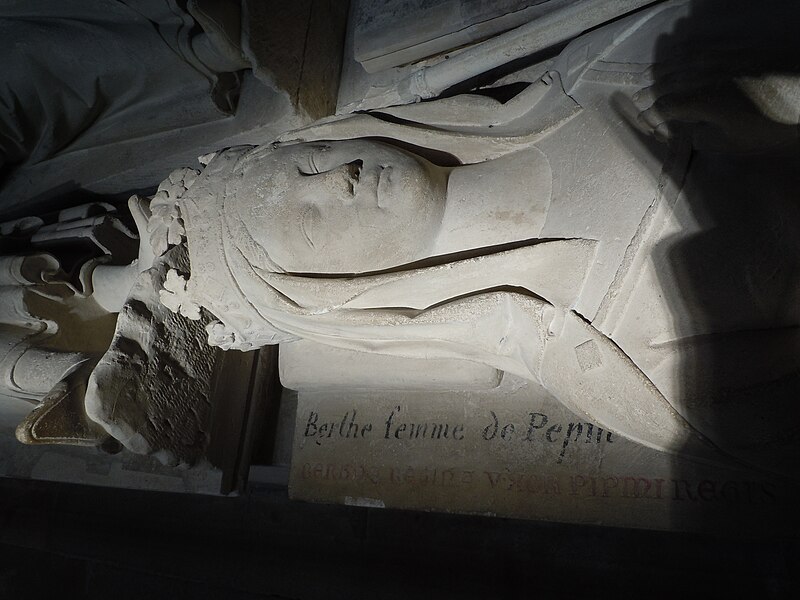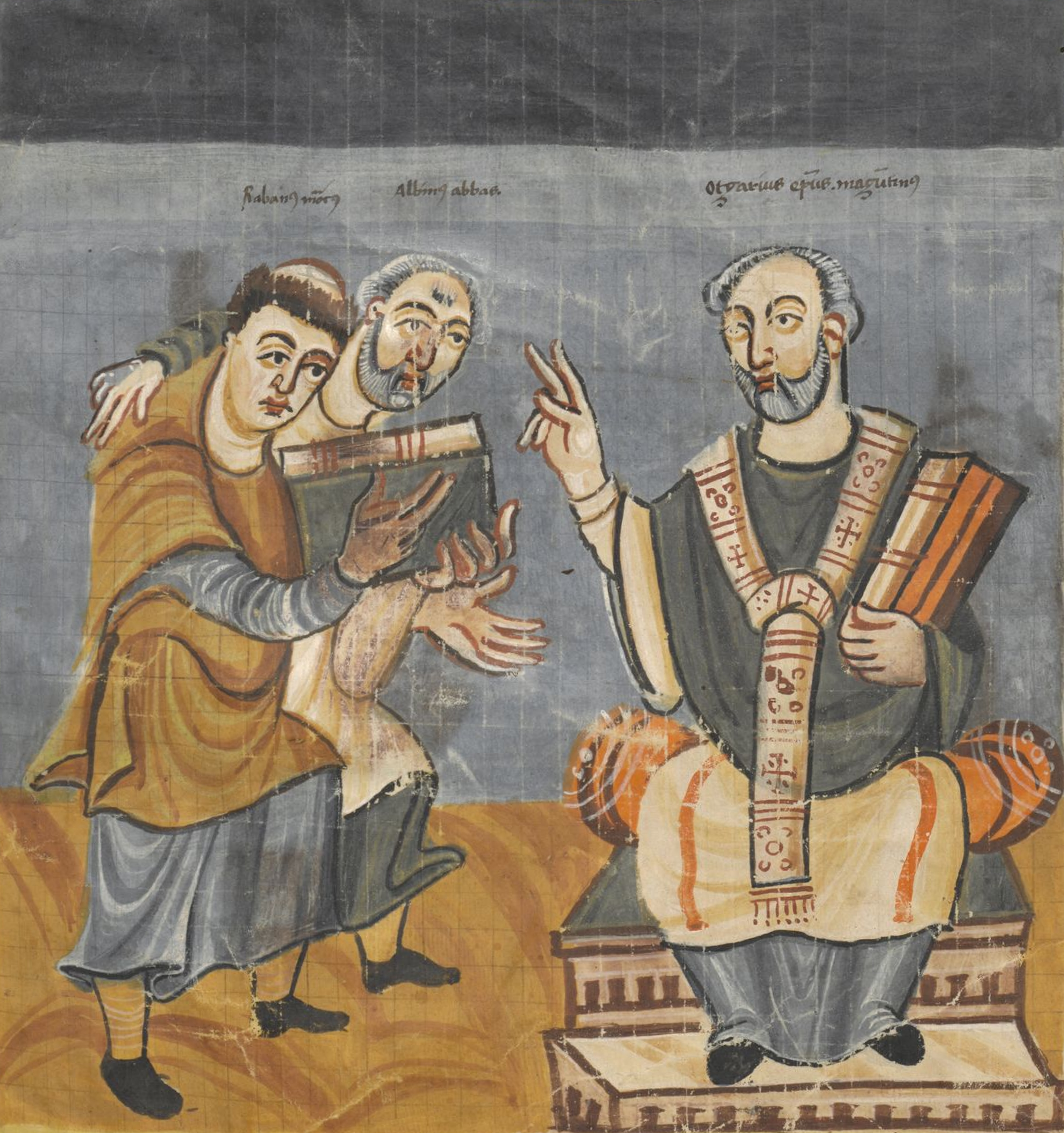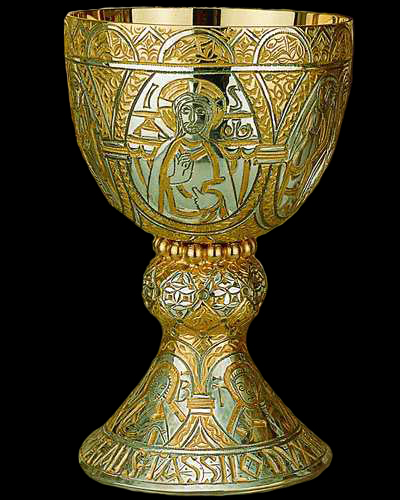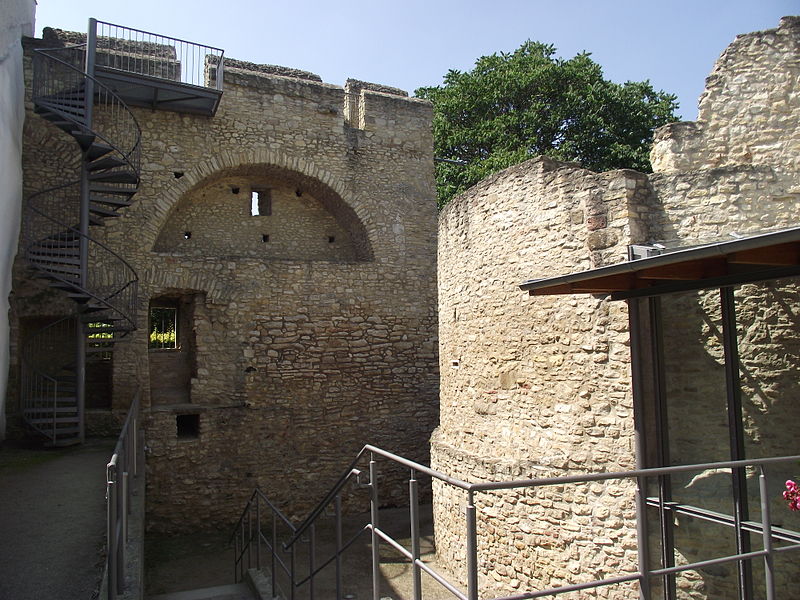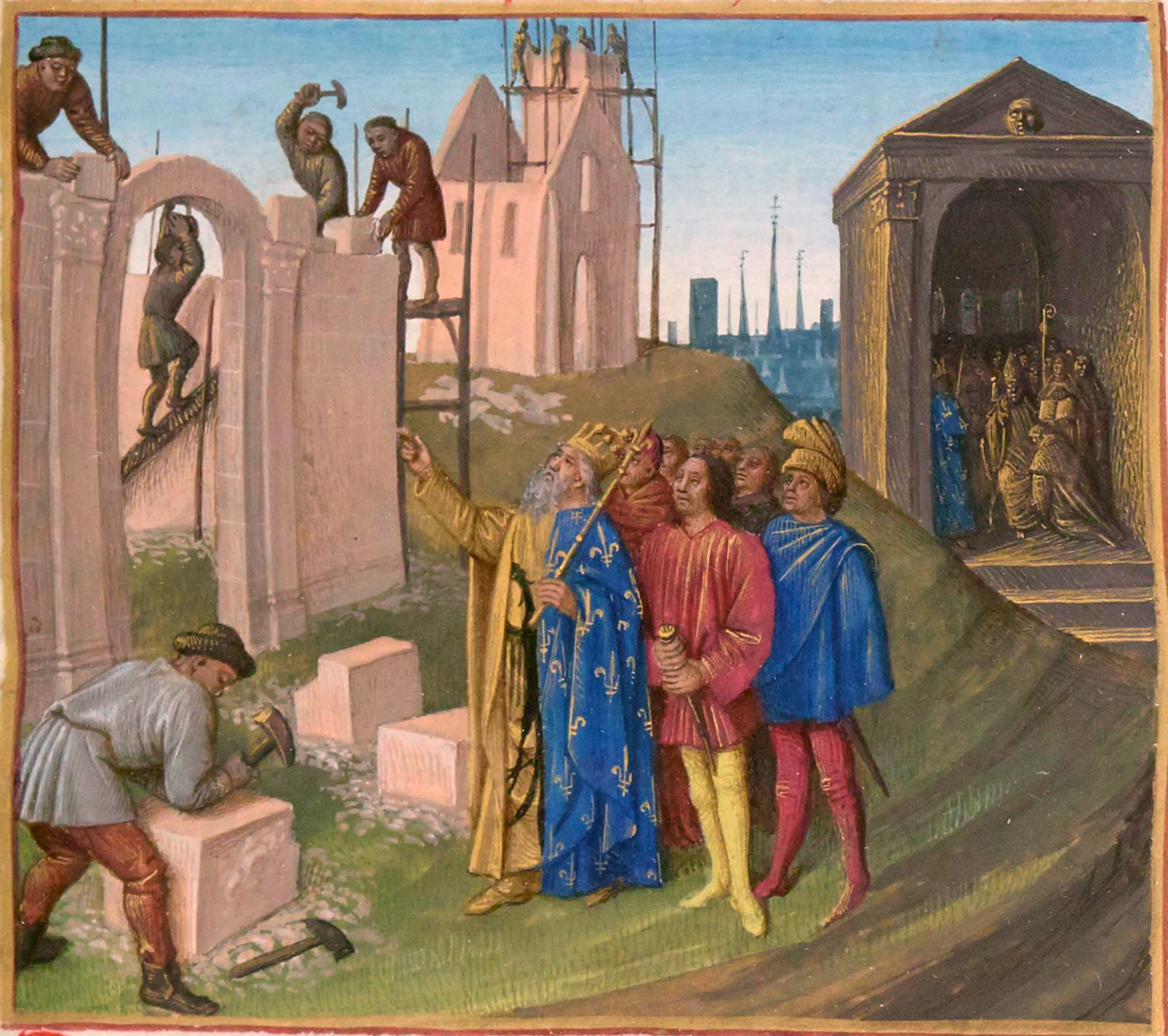 |
| Charles and Pepin the Hunchback |
Conspiracies Abound
In 786 a
conspiracy was uncovered, centred in the north-east of Francia. These lands had
borne the brunt of the majority of the campaigning against the Saxons. One
Count Hardrad and his neighbours planned to kidnap Charles to extract more
rewards for their services to the crown. The plot was betrayed and three of the
conspirators were executed while the remainders had their eyes put out and were
shut up in monasteries.
In 792
another conspiracy came to light involving Charles’ illegitimate and firstborn
son Pepin the Hunchback and a number of the Frankish nobility. Pepin felt that
he’d been denied his birth right as Charles’ eldest son. When the call came to
attack the Avars Pepin claimed to be sick and stayed home. He planned to raise
large numbers of supporters while Charles was away and proclaim himself king.
There were a
significant number of Frankish nobles concerned about the autocracy Charles had
created. A young monk overheard the plotters and reported the conspiracy to
Charles. The supporters were rounded up and charged with violating their oath
of allegiance to Charles and his family. The rebels claimed they’d never been
asked to swear the oath;
 |
| Relic from Prum Abbey, given to Pepin's grandfather |
When Charles, after the
beginning of the war against the Huns, was wintering in Bavaria, this Pippin
pretended illness, and formed a conspiracy against his father with some of the
leaders of the Franks, who had seduced him by a vain promise of the kingdom.
When the design had been detected and the conspirators punished Pippin was
tonsured and sent to the monastery of Prumia, there to practise the religious
life.’[i]
Following the quelling of the rebellion Charles summonsed an assembly at
Regensburg and the nobles present adjudged Pepin and his adherents guilty and
discussed the political consequences of rebelling against the throne. Most of the conspirators were
beheaded while Pepin was sent to the monastery of Prüm.
Family Affairs
 |
| Coin depicting Offa |
Around 789,
Charles proposed that his son Charles the Younger marry Ælfflæd, the daughter of King Offa of Mercia. Offa insisted that the marriage could only go ahead if Charles’
daughter Bertrada married Offa's son Ecgfrith. Charles took offence, broke off
contact, and closed his ports to English traders. Eventually normal relations
were re-established and the ports were reopened.
Fastrada
died on 10 August 794 in Frankfurt, Germany, during the synod of Frankfurt.
She was buried in St. Alban's Abbey, Mainz, long before the building was finished. Einhard had no great
opinion of Fastrada[ii];
talking of the two conspiracies against Charles he recorded;
‘The cruelty of Queen
Fastrada is believed to be the cause and origin of these conspiracies. Both
were caused by the belief that, upon the persuasion of his cruel wife, he had
swerved widely from his natural kindness and customary leniency’[iii]
Einhard
attempts to throw all the blame for any claims of cruelty onto Fastrada. His
claims that Charles was unnaturally kind to all and sundry are not true; he did
give way to his temper at times, kind kings do not usually reign long in
turbulent times.
Charles,
from the very beginning, had decided he would do whatever was necessary to keep
himself on the throne of Francia, stamping his will on his subjects. He is
unlikely to have been influenced by Fastrada, who was only 21 at the time of
the first conspiracy. Einhard’s embellishing of Charles’ reputation was part in
justification of his new master’s right to rule after his father.
Charles was
an unusually tall man for the age; Einhard informs us that he was seven times
the length of his feet high[iv].
It is likely that he towered over most of the other men at court, useful for
dominating those around him.
Not long
after Fastrada’s death Charles married Luitgard, his last wife who died childless six years later in 800. The same year
Charles picked a concubine named Regina who had two sons, Drogo[v] born in 801 and Hugh[vi] in 802. Charles’ final concubine was
Ethelind who gave him two sons, Richbod[vii]
in 805 and Theodoric in 807 who died the same year as his birth.
Death of a Pontiff
 |
| Leo III |
On 25th
December 795 Pope Hadrian died; Charles sorrowed at the death;
‘When the death of Hadrian,
the Roman Pontiff, whom he reckoned as the chief of his friends, was announced
to him, he wept for him as though he had lost a brother or a very dear son.[viii]
Hadrian and
Charles had worked together for twenty three years[ix];
the pair established a relationship built on mutual respect and affection.
Hadrian was appreciative of Charles’ support in protecting the papal estates.
In Francia Charles had involved himself in church affairs, writing to bishops
about clerical morals, discussing points of doctrine with theologians and
deciding who to appoint to the dioceses he carved out in his kingdom. Charles
refused to augment papal authority and refused to be used as a stick to beat
Hadrian’s enemies.
Pope Leo III was elected on the 26th
December that Hadrian was buried and was consecrated on the following day[x].
Leo wrote to Charles informing him that he had been unanimously elected pope.
With the letter Leo enclosed the keys of the confession of St. Peter, and the
standard of the city, and requested an envoy. His letter was an assurance that
Charles was viewed as the protector of the Holy See.
Emperor of the Romans
 |
| Leo III meets with Charles |
In Byzantium
in the summer of 797 the Empress Irene deposed her son Constantine VI, in
retaliation for his having banished her in 790. Her supporters captured and
blinded him[xi];
Irene then made herself Empress Regnant. This action by a mere female was to have wide-ranging repercussions.
On 25th
April 799 Pope Leo was ambushed by a group of Roman nobles[xii]
who attempted to put Leo’s eyes out and cut out his tongue[xiii].
He managed to escape and fled to Charles who was holding court at Paderborn,
preparing for another war against the Saxons. Leo returned to Rome in November
and was accused by his enemies of simony, perjury and adultery among other crimes.
In November
800 Charles travelled to Rome where he met with both parties to the quarrel. Alcuin
had been talking for some time of Charles’ imperium
and had recently written to Charles reminding him that Empress Irene’s actions
had upset the world order; females were incapable of ruling and so Irene was
not able to be Leo’s judge. In Alcuin’s eyes that role should fall upon the
male and very capable Charles.
 |
| Leo crowns Charles as Emperor |
On 23rd
December at the high altar Leo swore that he was not guilty of the crimes
charged against him. That he was not instantly struck down by a thunderbolt (or
similar) from God was clear proof of his innocence. On 25th
December, two days after taking the oath in an allegedly surprise move, Leo
crowned Charles Emperor of the Romans[xiv].
‘He therefore came to Rome
to restore the condition of the church, which was terribly disturbed, and spent
the whole of the winter there. It was then that he received the title of
Emperor and Augustus, which he so disliked at first that he affirmed that he
would not have entered the church on that day—though it was the chief festival
of the church—if he could have foreseen the design of the Pope.’[xv]
There has
been much debate about the significance of this coronation and as to whether
Charles was quite as surprised as Einhard claimed. There had been plenty of
time in Paderborn for Charles and Leo to discuss the possibility and may have
been a quid pro quo for Charles acceptance of Leo’s oath that he was innocent
of the charges made against him.
Piggy in the Middle
.jpg/323px-Irina_(_Pala_d'Oro).jpg) |
| Empress Irene |
Charles elevation
to the imperium greatly offended the rulers of Byzantium who refused to accept
the division of the old Roman Empire into east and west. They took Charles’
actions in Italy as encroachment on lands that divided the two empires.
Charles had
no intention of attacking Byzantium; he may have hoped for submission from
Irene whose rule was not popular among her nobles and officials. Rumours of a
marriage between the Empress and the barbarian swirled around Constantinople
and led in part to a palace coup headed by Irene’s chancellor Nicephorus in 802[xvi].
For the rest
of Charles’ reign a state of cold war existed between the two empires;
Nicephorus and his successors were suspicious of Charles’ motives;
‘The Emperors of
Constantinople, Nicephorus, Michael, and Leo, too, made overtures of friendship
and alliance with him, and sent many ambassadors. At first Charles was regarded
with much suspicion by them, because he had taken the imperial title, and thus
seemed to aim at taking from them their empire.’[xvii]
In 803
Nicephorus sent a peace delegation to Charles; the two empires had exchanged
ambassadors the previous year. But the Byzantines encouraged the city of
Benevento to throw off its Frankish overlordship. King Pepin launched campaigns
in 801 and 810 but neither was successful. In 802 the Duke of Benevento
captured Winigis, one of Charles’ most trusted
lieutenants, at the siege of Lucera.
Bibliography
Celts and Saxons – Peter Berrisford Ellis, Constable and Company Ltd
1995
The Cambridge Illustrated History of the Middle Ages – Robert Fossier
(ed), Cambridge University Press 1989
The Holy Roman Empire – Friedrich Heer, Phoenix 1999
The Oxford History of Medieval Europe – George Holmes, Oxford University
Press 2001
The Year 1000 – Robert Lacey & Danny Danziger, Abacus 2007
Absolute Monarchs – John Julius Norwich, Random House 2011
Emperor of the West – Hywel Williams, Quercus 2010
Charlemagne – The Great Adventure – Derek Wilson, Hutchinson 2005
[ii]
He was writing during the reign of Charles’ son and successor who can have been
only too willing to allow his stepmother to take the blame for the problems
Charles faced during the period
[iv]
His skeleton was measured in 1861; Charles was 6’ 5”
[vii]
Later Abbot of St Riquier
[ix]
One of the longest reigning pontiffs
[x]
It is possible that this haste was
due to a desire on the part of the church to forestall any interference by the
Franks with their freedom of election
[xi]
It is believed that he died shortly thereafter
[xii]
Led by Hadrian’s nephew; Hadrian’s family, one of the Roman noble families, had
apparently expected that one of their number would receive the papal tiara
[xiii]
Which would oblige Leo to renounce the papacy
[xiv]
Or Holy Roman Emperor
